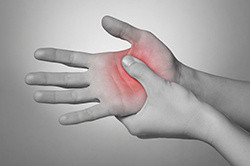 According to the Bureau of Labor Statistics, musculoskeletal disorders (MSDs) accounted for 32% of all worker injury and illness cases in 2014. And OSHA cites work-related MSDs as one of the most frequently reported causes of lost or restricted work time.
According to the Bureau of Labor Statistics, musculoskeletal disorders (MSDs) accounted for 32% of all worker injury and illness cases in 2014. And OSHA cites work-related MSDs as one of the most frequently reported causes of lost or restricted work time.
So what can you do to reduce the risk of MSDs in your workplace? The answer is found in ergonomics, or the science of fitting the job to the employee. By implementing an ergonomic process, work-related MSDs can be prevented – improving your workplace safety, reducing lost work time, and even reducing workers’ compensation claims.
OSHA And Ergonomics
There are several industry-specific guidelines provided by OSHA regarding ergonomics. But even if you are not in one of these industries, ergonomics should still be part of your workplace safety program. Here’s what OSHA has to say on the matter: “Even if there are no guidelines specific to your industry, as an employer you still have an obligation under the General Duty Clause, Section 5(a)(1) to keep your workplace free from recognized serious hazards, including ergonomic hazards.”
When looking at alleged ergonomic hazards OSHA considers the following criteria, which are based on the General Duty Clause:
- whether an ergonomic hazard exists
- whether that hazard is recognized
- whether the hazard is causing, or is likely to cause, serious physical harm to employees
- whether a feasible means exists to reduce the hazard
Identify Problems
By being proactive, you can identify ergonomic problems in your workplace BEFORE they result in MSDs. Consider the following three components of the identification process:
- Review Injury Records
- Observe Workplace Conditions
- Encourage Early Reporting
Review Injury Records
Conducting a periodic review of your injury records can help in identifying potential ergonomic issues. Take a look at your OSHA 300 injury and illness logs, accident investigation forms, workers’ compensation records, and workers’ reports of problems.
Observe Workplace Conditions
Look critically at your workplace – the facility, workstation designs, work practices, processes, and your workers themselves.
Keep an eye out for risk factors. What may lead to the development of MSDs in your workforce? OSHA identifies the following risk factors:
- Exerting excessive force. Examples include lifting heavy objects or people, pushing or pulling heavy loads, manually pouring materials, or maintaining control of equipment or tools.
- Performing the same or similar tasks repetitively. Performing the same motion or series of motions continually or frequently for an extended period of time.
- Working in awkward postures or being in the same posture for long periods of time. Using positions that place stress on the body, such as prolonged or repetitive reaching above shoulder height, kneeling, squatting, leaning over a counter, using a knife with wrists bent, or twisting the torso while lifting.
- Localized pressure into the body part. Pressing the body or part of the body (such as the hand) against hard or sharp edges, or using the hand as a hammer.
- Cold temperatures. In combination with any one of the above risk factors may also increase the potential for MSDs to develop. For example, many of the operations in meatpacking and poultry processing occur with a chilled product or in a cold environment.
- Both whole body and hand-arm vibration can cause a number of health effects. Hand-arm vibration can damage small capillaries that supply nutrients and can make hand tools more difficult to control. Hand-arm vibration may cause a worker to lose feeling in the hands and arms resulting in increased force exertion to control hand-powered tools (e.g. hammer drills, portable grinders, chainsaws) in much the same way gloves limit feeling in the hands. The effects of vibration can damage the body and greatly increase the force which must be exerted for a task.
- Combined exposure to several risk factors. May place workers at a higher risk for MSDs than does exposure to any one risk factor.
By observing workers, you might notice some outwards signs that can mean individuals are experiencing ergonomic problems. Are they….
- Modifying their tools, equipment, or work area?
- Vigorously sharking their hands and wrists?
- Rolling their shoulders?
- Unconscious massaging of hands, wrists, or arms?
- Cradling of their arms to give extra support of to hold the arm in a position that reduces pain?
- Bringing in back belts, wrist braces, or other similar products?
If you notice these behaviors, seek information. Talk to these individuals and see if any of the risk factors are present. Your workers can often provide information about the hazards they are experiencing and valuable suggestions for change.
Encourage Early Reporting Of Injury
By utilizing comprehensive injury reporting, you are able to properly assess, diagnose, and treat MSDs. The benefits of early reporting, diagnosis and intervention are vast. You can limit the severity of the injury itself, improve the effectiveness of the treatment, minimize the likelihood of permanent damage or disability, and even reduce workers’ compensation claims. It also helps the employer accurately identify work areas or tasks where injuries are frequently occurring or are most severe – giving you guidance for your ergonomics efforts and assisting health care providers with return-to-work decisions.
Taking the time to implement an ergonomic process at your organization can help improve workplace safety and prevent MSDs. Make it part of your company’s safety efforts!



